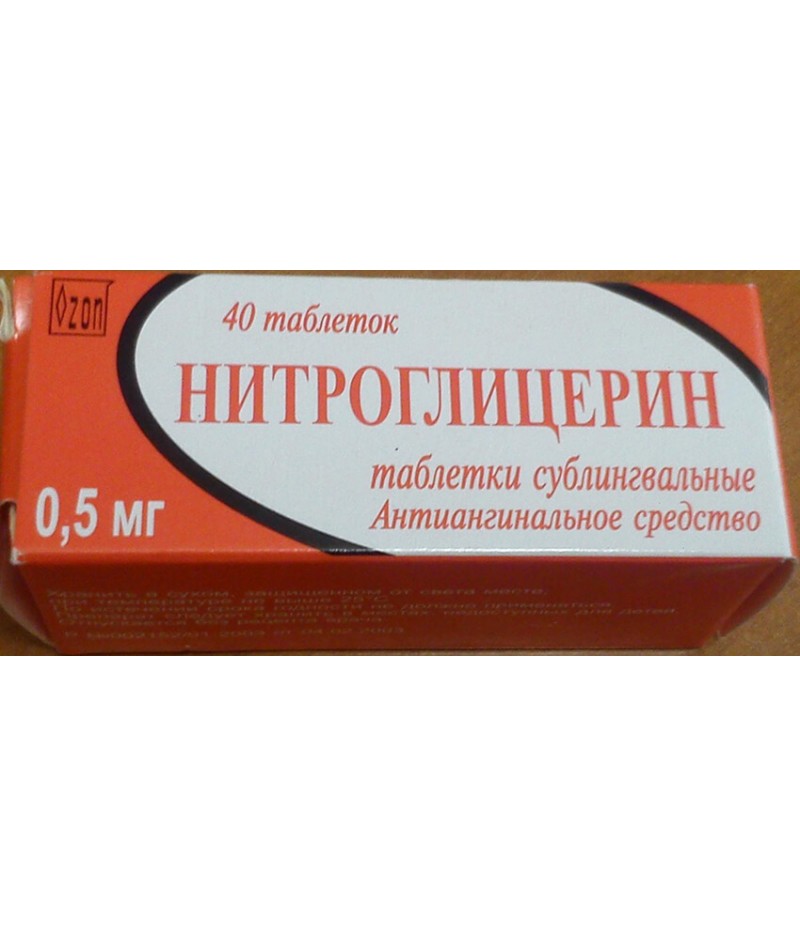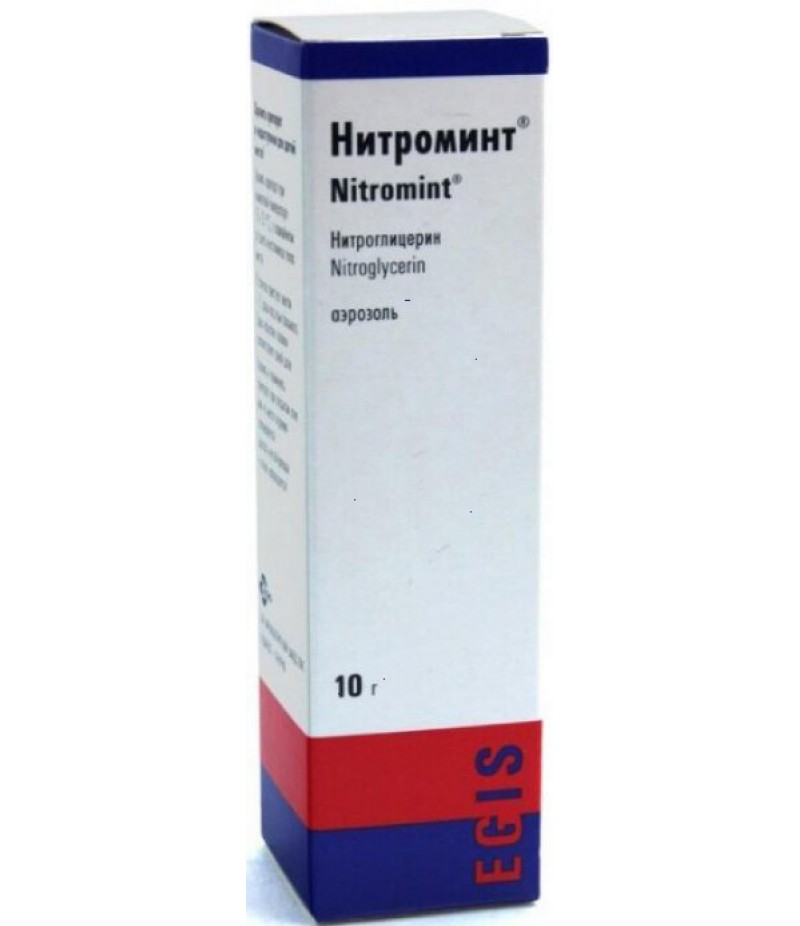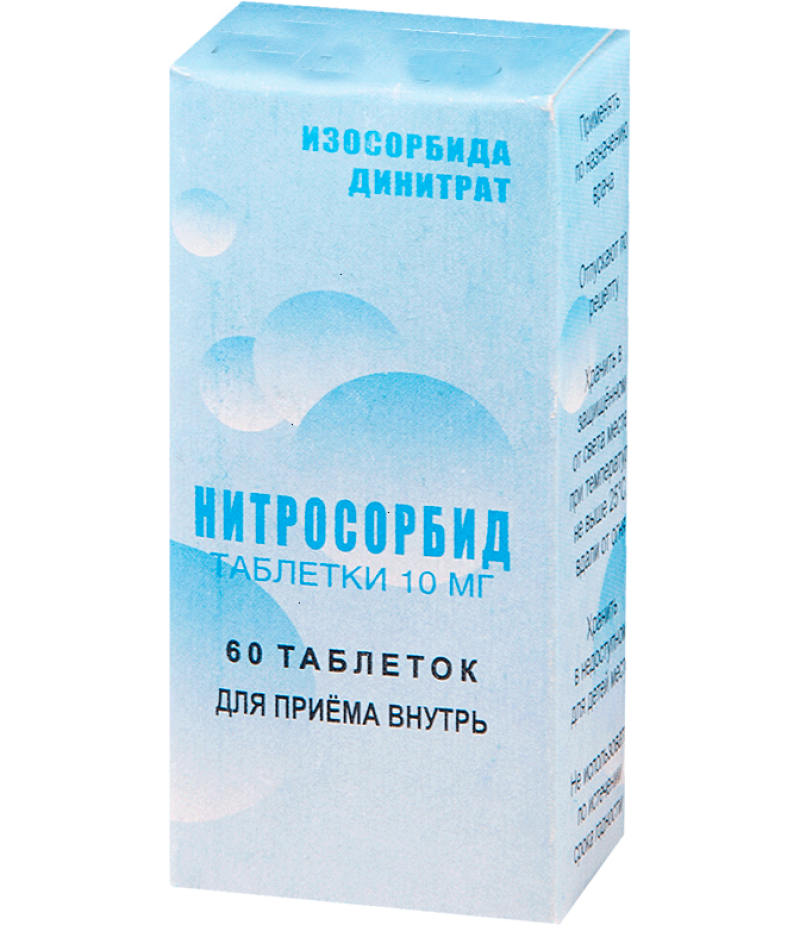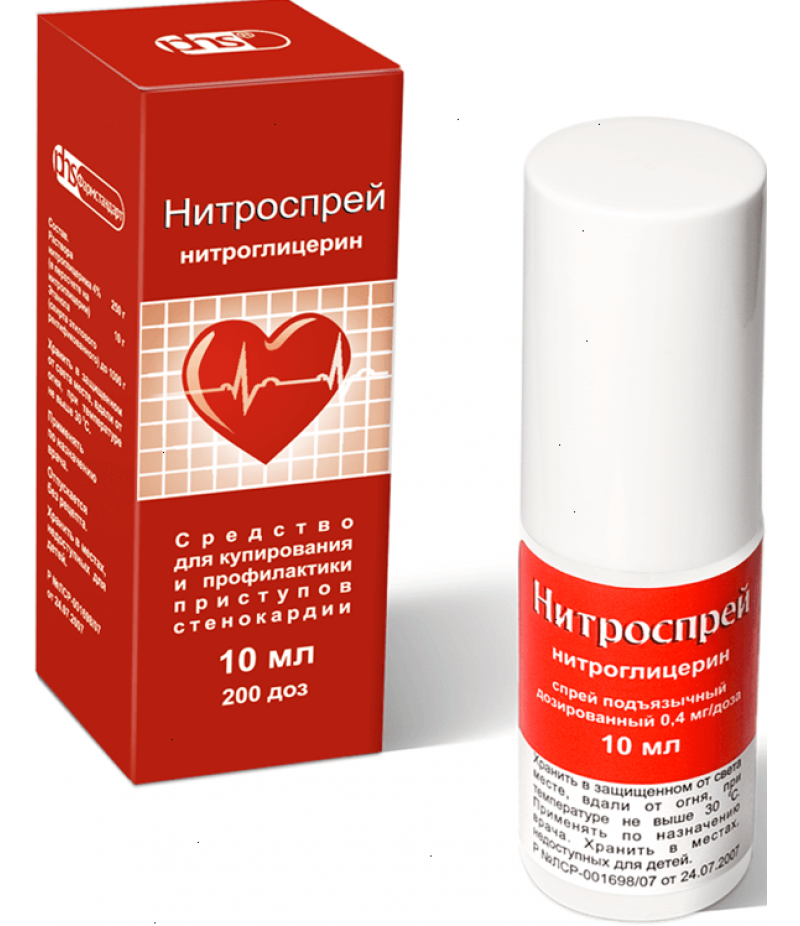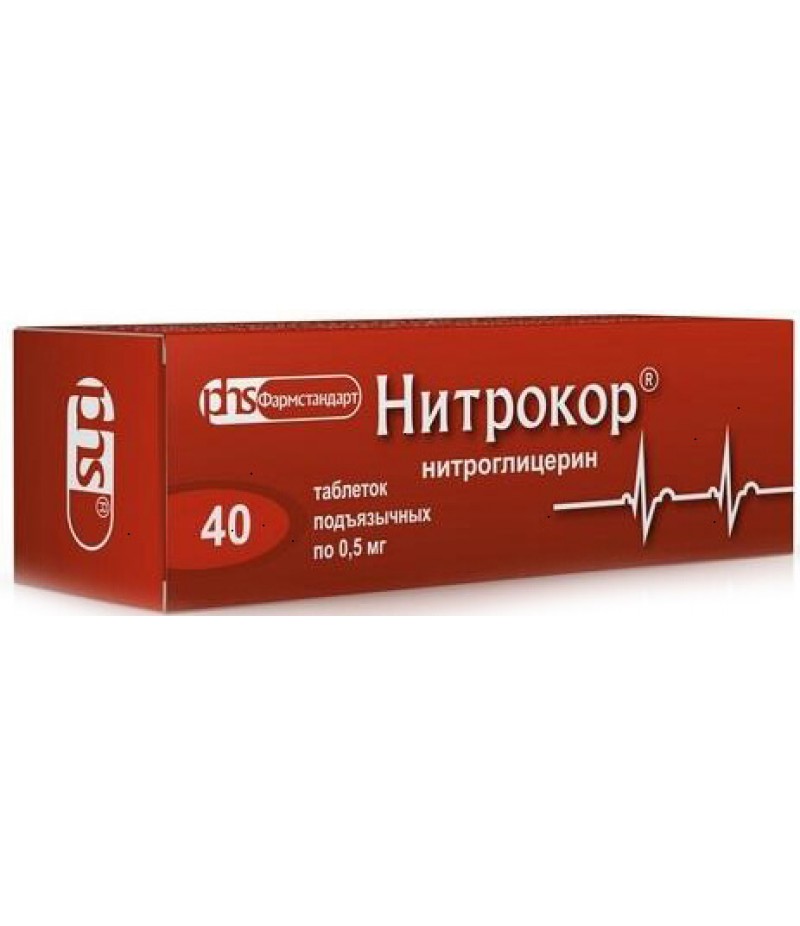Nitroglycerin tabs 0.5mg #40
- $4.25
- 3 or more $3.99
- Availability:In Stock
Nitroglycerin instructionReed more and buy Nitroglycerin tabs on this pageCompositionNitroglycerin sublingual tablets contain the active ingredient nitroglycerin and additional components: lactose, crospovidone CL, macrogol 6000, ..
Tags: tabs
Nitroglycerin instruction
Reed more and buy Nitroglycerin tabs on this page
Composition
Nitroglycerin sublingual tablets contain the active ingredient nitroglycerin and additional components: lactose, crospovidone CL, macrogol 6000, povidone 25.
Form of issue
Produced in the form of tablets that take sublingually. Tablets are white or white with a yellowish hue. The tablet can be rough externally. Contained in polymer containers or in cell contour packs. In packages from 10 to 100 pieces.
A solution of Nitroglycerin 1% in ampoules of 5 ml and 1% solution of nitroglycerin in oil in capsules is also produced.
Spray sublingual Nitroglycerin - a clear liquid without color, contained in 10 ml vials, complete with a mechanical dosing pump.
Also, there are other forms of release of the drug - sublingual drops, concentrate for the preparation of a solution for the administration of the substance nitroglycerin IV, films on the gum.
pharmachologic effect
Nitroglycerin is a nitrogen-containing organic compound that primarily has a venodilating effect.
The formula of nitroglycerin: C3H5N3O9.
Pharmacological group of the drug: nitrates and nitrate-like agents.
The reaction of obtaining a nitroglycerin substance is described in textbooks on chemistry. Nitroglycerin is an explosive substance, but the preparation contains a very low concentration.
The substance acts because of the release of nitrogen oxide from the molecule, which is a natural relaxing endothelial factor. The mechanism of action of nitroglycerin is the following: under the influence of nitric oxide within the cells, the concentration of cyclic guanosine monophosphatase increases, as a result, an obstacle is formed for the entry of calcium ions into the smooth muscle cells. In this case, smooth muscle cells relax, the vessels expand, which reduces the venous return to the heart and resistance to a large range of blood circulation, i.e. preload and postload. As a result, the need for myocardium in oxygen decreases.
Due to the expansion of coronary vessels, coronary blood flow is activated, redistributing in the area where blood circulation is reduced. This helps improve oxygen delivery to the myocardium.
After the decrease in venous return, the filling pressure decreases, the blood flow in the subendocardial layers improves, the pressure in the small circle of blood circulation decreases, and the regression of symptoms decreases in patients with pulmonary edema.
Wikipedia testifies that nitroglycerin has a central inhibitory effect on sympathetic vascular tone, while inhibiting the vascular component of the formation of pain syndrome. Under the influence of nitroglycerin, smooth muscle cells of the bronchi, gall bladder, urinary tract, esophagus, bile ducts, intestines are relaxed.
Pharmacokinetics and pharmacodynamics
Nitroglycerin when applied sublingually begins to act after 1-1.5 minutes after use. The effect lasts for about thirty minutes. From the surface of the mucous is absorbed quickly and completely. Immediately enters the systemic circulation. If the agent is used in a dose of 0.5 mg, its bioavailability is 100%, and the maximum plasma concentration is noted after 5 minutes. The volume of distribution is very large. With plasma proteins, communication is 60%.
When you take the spray, it is quickly and completely absorbed. The maximum concentration in plasma is noted after 4 minutes. Metabolism passes quickly, with the participation of nitrate reductase. In this case, di- and mononitrates are formed, the final metabolite is glycerol. It is excreted through the kidneys. In unchanged form, less than 1% of the dose is taken. The half-life at admission sublingually is 2.5-4.4 min.
Nitroglycerin accumulates in the walls of blood vessels and binds firmly to erythrocytes.
Indications for use Nitroglycerin
There are the following indications for the use of Nitroglycerin:
with the purpose of elimination of attacks of a stenocardia;
for dyskinesia of bile ducts;
with embolism of the central artery of the retina;
with left ventricular failure (the procedure is indicated for myocardial infarction).
Contraindications
Do not apply the drug to people who have the following diseases and conditions of the body:
high sensitivity of the organism to nitrates;
cardiac tamponade;
hypertension craniocerebral;
constrictive pericarditis (if there is a decrease in the filling pressure of the left ventricle);
uncontrolled hypovolemia;
isolated mitral stenosis;
heart failure (under conditions of low or normal pulmonary artery pressure);
stroke hemorrhagic;
collapse;
hemorrhage subarachnoid;
head trauma suffered by the patient recently;
pulmonary edema is toxic;
idiopathic hypertrophic subaortic stenosis;
glaucoma (closed-angle form) under the condition of high intraocular pressure;
hyperthyroidism;
severe anemia;
patient's age under 18;
shock;
impaired cerebral circulation;
arterial hypotension;
when taking Sildenafil (Viagra);
pregnancy and natural feeding.
Before taking the drug in tablets or other forms, it should be noted that patients with severe renal failure and severe hepatic insufficiency Nitroglycerin for the heart is prescribed with caution.
Side effects
Before you buy Nitroglycerin you should know side effects of the drug.
During the application of Nitroglycerin in patients often develop a transient headache, there may be a feeling of dizziness, sometimes lower blood pressure (this symptom often develops if a person is in a position vertically).
If there is an overdose of tablets and other forms of the drug, the patient may develop an orthostatic collapse, in this condition the patient's blood pressure drops sharply when the person moves from a horizontal position to a vertical one.
Thus, it should be borne in mind that such a drug can trigger the following side effects:
Nervous system, sensory organs: headache, feeling of head opening, dizziness, sensation of weakness, motor anxiety, impaired vision, psychotic manifestations, exacerbation of glaucoma.
The heart and blood vessels of the hematopoiesis system: a sensation of blood flushes to the face, hypotension, strong palpitations, methemoglobinemia, collapse.
Digestive system: vomiting, nausea, diarrhea, dry mouth.
Skin: skin hyperemia, cyanosis.
Allergy: burning sensation, itching, contact dermatitis (if transdermal forms are used).
Other manifestations: hypothermia, sensation of fever, development of paradoxical effects - ischemia, attack of angina pectoris, possible development of myocardial infarction with sudden death.
Instructions for use Nitroglycerin (Method and dosage)
In modern medicine, the use of an alcohol solution of nitroglycerin is sublingually used in rare cases. The solution is applied under the tongue - 2-3 drops or drop it on a piece of sugar.
Tablets Nitroglycerin, instructions for use
Applied tablets sublingually - kept under the tongue until complete resorption, while swallowing the tablet can not. Take the pill immediately after the development of pain, at 0.5-1 mg per reception. Often patients with stable angina mark the onset of the effect and after applying smaller doses (1 / 2-1 / 3 table). Therefore, if the pain has quickly passed, you can not dissolve the rest of the pill. As a rule, after resorption of the pill, the effect is manifested in 0.5-2 minutes, some patients note improvement in the state for 3-4 minutes.
If the antianginal effect is absent during the first 5 minutes, 0.5 mg should be taken. If even after taking two tablets there is no effect, you should immediately consult a doctor. After sublingual administration, the effect of Nitroglycerin continues for 45 minutes.
In rare cases, tolerance to Nitroglycerin (its sublingual forms) may develop, in which case the patient is gradually increased the dose - up to 2-3 tablets.
Overdose
In case of an overdose of the drug, the patient may experience headache, blood pressure is lowered, reflex tachycardia, orthostatic hypotension, dizziness, vomiting and diarrhea, red face, asthenia, fever, severe drowsiness.
It should be remembered that taking very high doses of the drug (that is, more than 20 mg / kg) can lead to cyanosis, methemoglobinemia, tachypnea, dyspnoea, orthostatic collapse. If a serious overdose has occurred, a fatal outcome is also possible. Death in case of an overdose of Nitroglycerin can occur if you do not provide timely help to a patient who has taken an excessive dose of the medicine. In this case, after a few hours, a coma may ensue, and later death.
If an easy overdose has occurred, you need to move a person to a reclining position, making it so that his legs are raised. If a severe overdose is noted, the use of general methods of therapy of shock and intoxication of the body is practiced. In particular, they replenish the volume of circulating blood, appoint Norepinephrine, Dopamine. It is contraindicated to use Epinephrine.
If a patient develops methaemoglobinemia, the practice of taking vitamin C in the form of sodium salt is taken orally or intravenously. Hemodialysis, oxygen therapy, blood transfusion is prescribed.
It should also be noted that the risk of serious consequences increases with the intake of nitroglycerin after alcohol. The lethal dose of nitroglycerin and alcohol is not defined, but with this combination at any doses the risk of serious consequences increases dramatically.
Interaction
The drug can interact with other drugs, from which Nitroglycerin should be taken with caution in such combinations:
With the simultaneous administration of salicylates, the level of nitroglycerin in the plasma increases.
At simultaneous reception of barbiturates the metabolism of nitroglycerin is activated. If nitroglycerin is taken simultaneously with adrenomimetics, their pressor effect will decrease.
Nitroglycerin lowers the anticoagulant effect of Heparin (when administered intravenously).
Hypotensive and systemic vasodilating effect of Nitroglycerin is enhanced by the simultaneous administration of antiadrenergic, hypotensive drugs, as well as Sildenafil citrate, vasodilators, tricyclic antidepressants, calcium antagonists, MAO inhibitors, quinidine, ethanol, Novocainamide.
Antianginal activity of Nitroglycerin increases with admission with N-acetylcysteine, Methionine, ACE inhibitors, salicylates.
When Unithiol is taken, reduced sensitivity to nitroglycerin is restored.
Antianginal and vasodilator action decreases with simultaneous administration of dihydroergotamine, alpha-adrenomimetics, m-cholinolytics, pituitrin, histamine, CNS stimulants, corticosteroids, vegetative ganglia, poisons of bees and snakes.
Storage conditions
It should be protected from moisture, stored at a temperature of no more than 25 ° C.
Shelf life - 2 years.
special instructions
It is necessary to ensure that the solution of Nitroglycerin does not get on the skin, as it can absorb and lead to the development of a headache.
It is necessary to take into account not only what the tablets are used for, but also their side effects. In particular, it should be remembered that when they are taken, blood pressure may drop drastically and dizziness may occur. These symptoms are most pronounced when drinking alcohol, during a hot period and under physical stress.
Over time, the patient may become addicted to the drug, so an increase in dose may be required. If the headache develops against the background of taking the drug, this symptom can be reduced by lowering the dose of the medicine or taking Validol simultaneously.
At reception reaction can be slowed down, therefore at this time it is not necessary to drive transport and to work with the exact and dangerous mechanisms.
To reduce the risk of side effects, you should not take the drug simultaneously with drugs that have an antihypertensive and vasodilating effect.
For the purpose of arresting an attack of angina pectoris, you can not chew the pill to prevent the ingestion of an excessive amount of active substance into the bloodstream.
Children
The use of nitroglycerin for the treatment of children is not practiced.
With alcohol
Do not take alcohol while Nitroglycerin, as the risk of serious side effects increases.
In pregnancy and lactation
Contraindicated during pregnancy and natural feeding. Possible reception only for life indications.
Reviews
Reviews suggest that this drug often becomes a real "rescuer" for people suffering from angina pectoris. Especially often it is used by elderly patients. Acts very quickly, relieves seizures. However, many patients note that when taking medication often develop side effects, most often - severe headache, dizziness.

